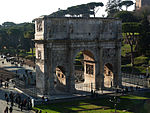Temple of Claudius
Ancient Roman religionBuildings and structures completed in the 1st centuryClaudiusRoman temples of the Imperial cultRome R. XIX Celio

The Temple of Claudius (Latin: Templum Divi Claudii), also variously known as the Temple of the Divus Claudius, the Temple of the Divine Claudius, the Temple of the Deified Claudius, or in an abbreviated form as the Claudium, was an ancient structure that covered a large area of the Caelian Hill in Rome, Italy. It housed the Imperial cult of the Emperor Claudius, who was deified after his death in 54 AD.
Excerpt from the Wikipedia article Temple of Claudius (License: CC BY-SA 3.0, Authors, Images).Temple of Claudius
Piazza dei Santi Giovanni e Paolo, Rome Municipio Roma I
Geographical coordinates (GPS) Address Nearby Places Show on map
Geographical coordinates (GPS)
| Latitude | Longitude |
|---|---|
| N 41.887594444444 ° | E 12.493366666667 ° |
Address
Convento dei Padri Passionisti
Piazza dei Santi Giovanni e Paolo 13
00184 Rome, Municipio Roma I
Lazio, Italy
Open on Google Maps









